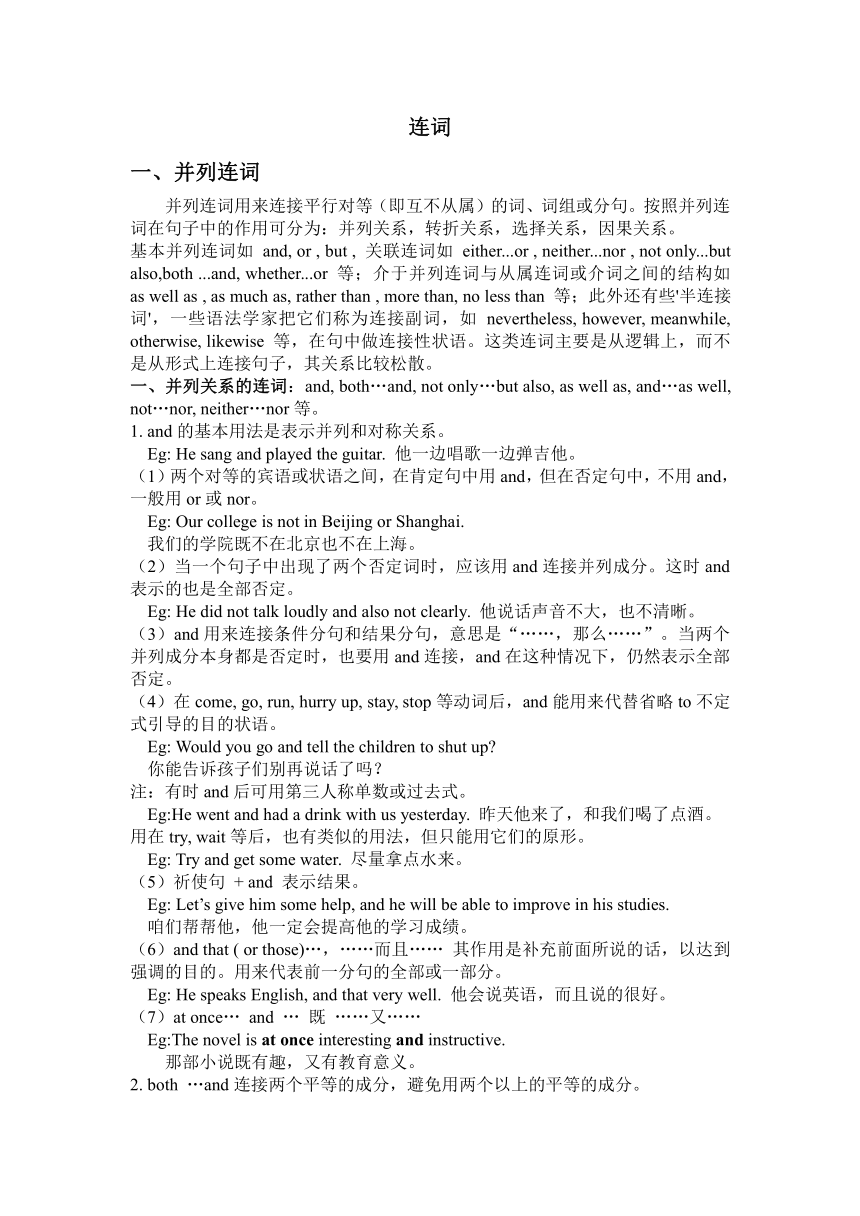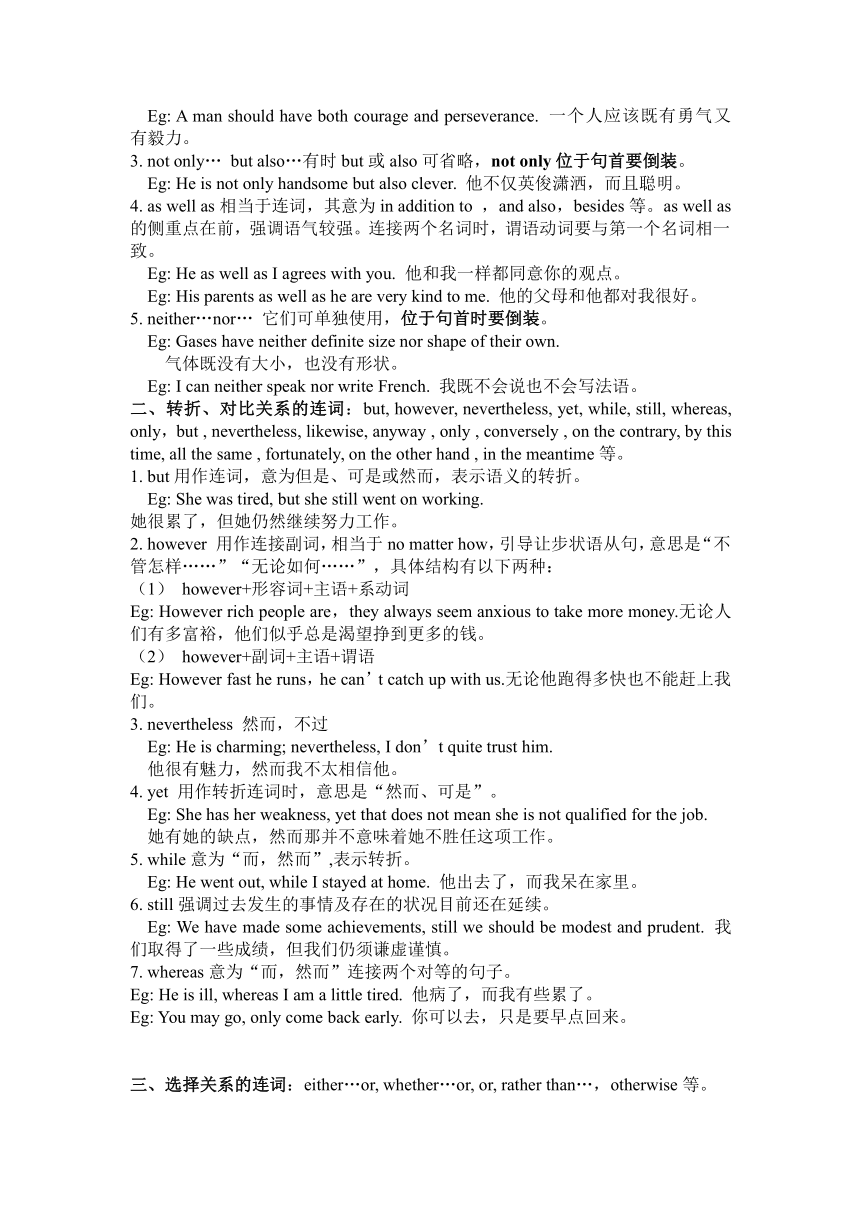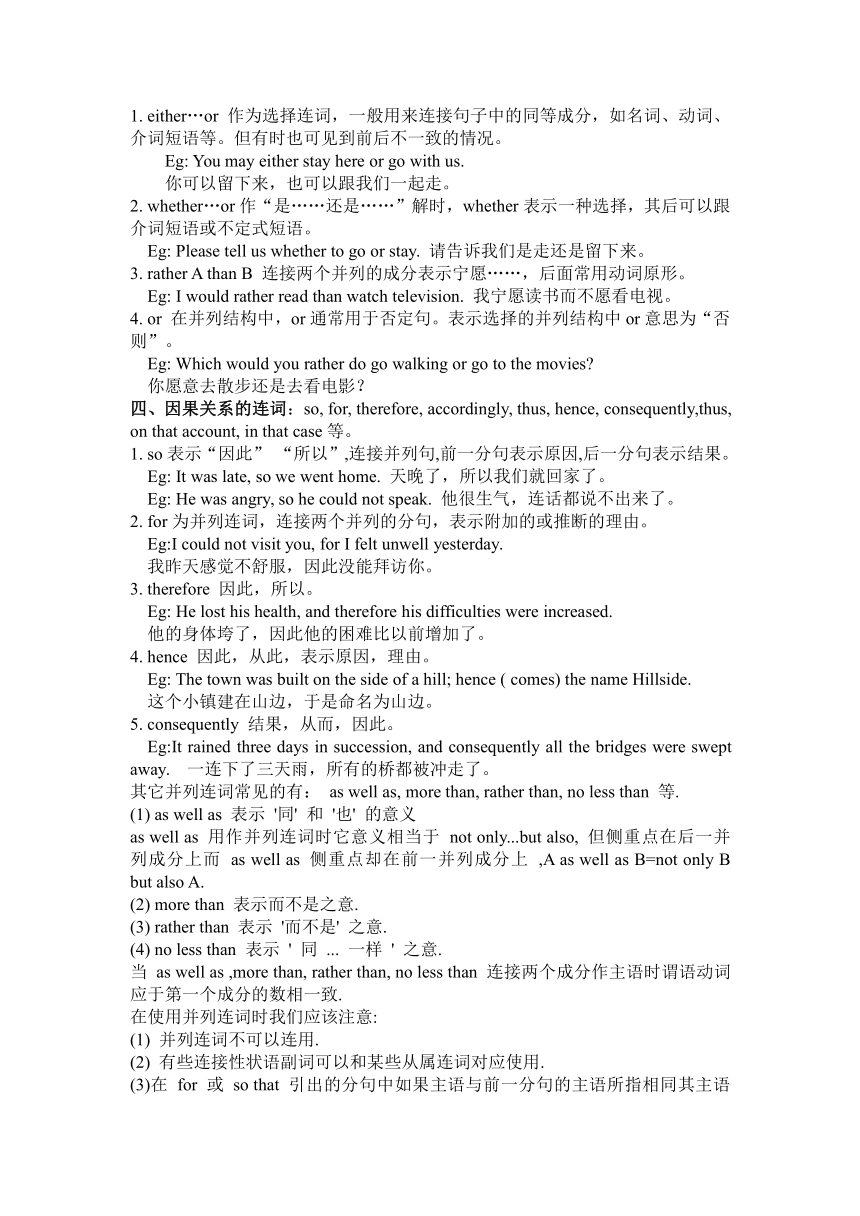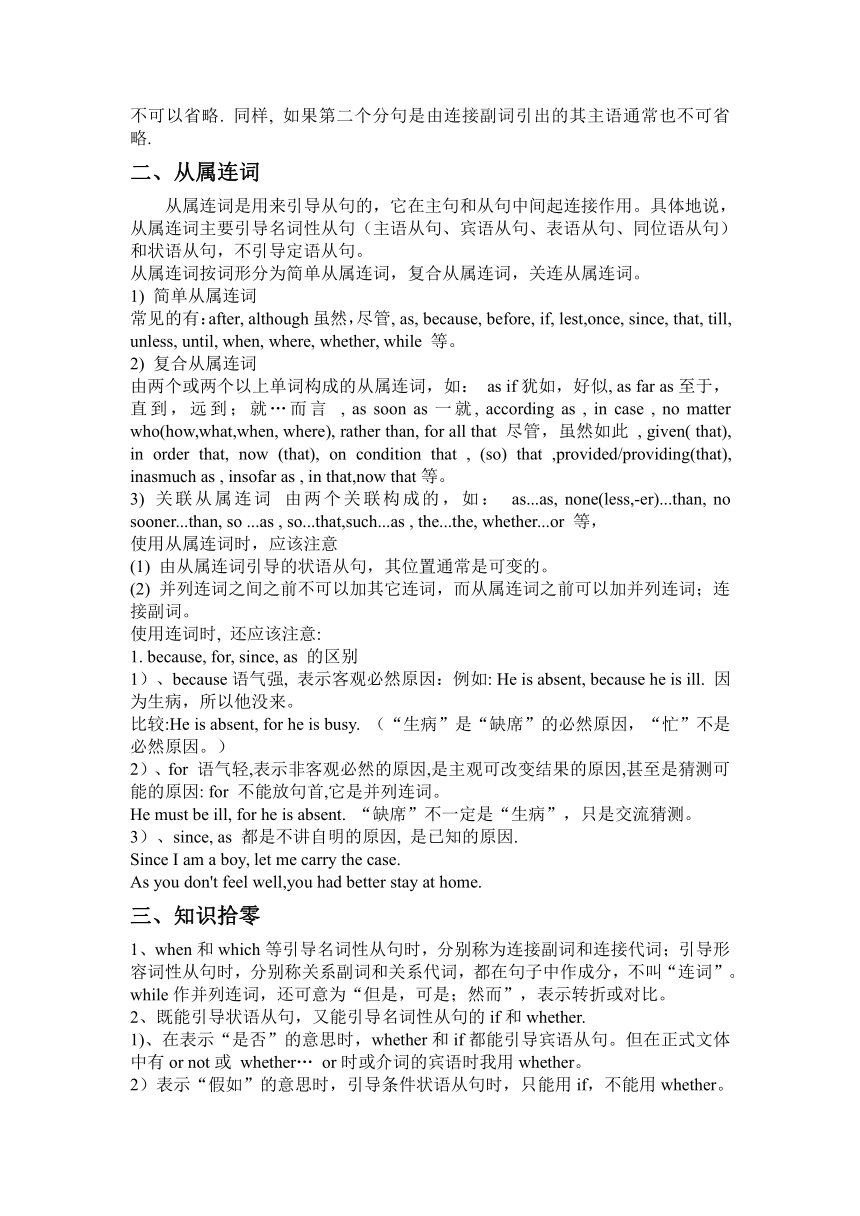2024年中考英语连词学案(含答案)
文档属性
| 名称 | 2024年中考英语连词学案(含答案) |  | |
| 格式 | docx | ||
| 文件大小 | 234.5KB | ||
| 资源类型 | 教案 | ||
| 版本资源 | 通用版 | ||
| 科目 | 英语 | ||
| 更新时间 | 2024-07-01 07:25:27 | ||
图片预览




文档简介
连词
一、并列连词
并列连词用来连接平行对等(即互不从属)的词、词组或分句。按照并列连词在句子中的作用可分为:并列关系,转折关系,选择关系,因果关系。
基本并列连词如 and, or , but , 关联连词如 either...or , neither...nor , not only...but also,both ...and, whether...or 等;介于并列连词与从属连词或介词之间的结构如 as well as , as much as, rather than , more than, no less than 等;此外还有些'半连接词',一些语法学家把它们称为连接副词,如 nevertheless, however, meanwhile, otherwise, likewise 等,在句中做连接性状语。这类连词主要是从逻辑上,而不是从形式上连接句子,其关系比较松散。
一、并列关系的连词:and, both…and, not only…but also, as well as, and…as well, not…nor, neither…nor等。
1. and的基本用法是表示并列和对称关系。
Eg: He sang and played the guitar. 他一边唱歌一边弹吉他。
(1)两个对等的宾语或状语之间,在肯定句中用and,但在否定句中,不用and,一般用or或nor。
Eg: Our college is not in Beijing or Shanghai.
我们的学院既不在北京也不在上海。
(2)当一个句子中出现了两个否定词时,应该用and连接并列成分。这时and表示的也是全部否定。
Eg: He did not talk loudly and also not clearly. 他说话声音不大,也不清晰。
(3)and用来连接条件分句和结果分句,意思是“……,那么……”。当两个并列成分本身都是否定时,也要用and连接,and在这种情况下,仍然表示全部否定。
(4)在come, go, run, hurry up, stay, stop等动词后,and能用来代替省略to不定式引导的目的状语。
Eg: Would you go and tell the children to shut up
你能告诉孩子们别再说话了吗?
注:有时and后可用第三人称单数或过去式。
Eg:He went and had a drink with us yesterday. 昨天他来了,和我们喝了点酒。
用在try, wait等后,也有类似的用法,但只能用它们的原形。
Eg: Try and get some water. 尽量拿点水来。
(5)祈使句 + and 表示结果。
Eg: Let’s give him some help, and he will be able to improve in his studies.
咱们帮帮他,他一定会提高他的学习成绩。
(6)and that ( or those)…,……而且…… 其作用是补充前面所说的话,以达到强调的目的。用来代表前一分句的全部或一部分。
Eg: He speaks English, and that very well. 他会说英语,而且说的很好。
(7)at once… and … 既 ……又……
Eg:The novel is at once interesting and instructive.
那部小说既有趣,又有教育意义。
2. both …and连接两个平等的成分,避免用两个以上的平等的成分。
Eg: A man should have both courage and perseverance. 一个人应该既有勇气又有毅力。
3. not only… but also…有时but或also可省略,not only位于句首要倒装。
Eg: He is not only handsome but also clever. 他不仅英俊潇洒,而且聪明。
4. as well as相当于连词,其意为in addition to ,and also,besides等。as well as的侧重点在前,强调语气较强。连接两个名词时,谓语动词要与第一个名词相一致。
Eg: He as well as I agrees with you. 他和我一样都同意你的观点。
Eg: His parents as well as he are very kind to me. 他的父母和他都对我很好。
5. neither…nor… 它们可单独使用,位于句首时要倒装。
Eg: Gases have neither definite size nor shape of their own.
气体既没有大小,也没有形状。
Eg: I can neither speak nor write French. 我既不会说也不会写法语。
二、转折、对比关系的连词:but, however, nevertheless, yet, while, still, whereas, only,but , nevertheless, likewise, anyway , only , conversely , on the contrary, by this time, all the same , fortunately, on the other hand , in the meantime等。
1. but用作连词,意为但是、可是或然而,表示语义的转折。
Eg: She was tired, but she still went on working.
她很累了,但她仍然继续努力工作。
2. however 用作连接副词,相当于no matter how,引导让步状语从句,意思是“不管怎样……”“无论如何……”,具体结构有以下两种:
(1) however+形容词+主语+系动词
Eg: However rich people are,they always seem anxious to take more money.无论人们有多富裕,他们似乎总是渴望挣到更多的钱。
(2) however+副词+主语+谓语
Eg: However fast he runs,he can’t catch up with us.无论他跑得多快也不能赶上我们。
3. nevertheless 然而,不过
Eg: He is charming; nevertheless, I don’t quite trust him.
他很有魅力,然而我不太相信他。
4. yet 用作转折连词时,意思是“然而、可是”。
Eg: She has her weakness, yet that does not mean she is not qualified for the job.
她有她的缺点,然而那并不意味着她不胜任这项工作。
5. while意为“而,然而”,表示转折。
Eg: He went out, while I stayed at home. 他出去了,而我呆在家里。
6. still强调过去发生的事情及存在的状况目前还在延续。
Eg: We have made some achievements, still we should be modest and prudent. 我们取得了一些成绩,但我们仍须谦虚谨慎。
7. whereas意为“而,然而”连接两个对等的句子。
Eg: He is ill, whereas I am a little tired. 他病了,而我有些累了。
Eg: You may go, only come back early. 你可以去,只是要早点回来。
三、选择关系的连词:either…or, whether…or, or, rather than…,otherwise等。
1. either…or 作为选择连词,一般用来连接句子中的同等成分,如名词、动词、介词短语等。但有时也可见到前后不一致的情况。
Eg: You may either stay here or go with us.
你可以留下来,也可以跟我们一起走。
2. whether…or作“是……还是……”解时,whether表示一种选择,其后可以跟介词短语或不定式短语。
Eg: Please tell us whether to go or stay. 请告诉我们是走还是留下来。
3. rather A than B 连接两个并列的成分表示宁愿……,后面常用动词原形。
Eg: I would rather read than watch television. 我宁愿读书而不愿看电视。
4. or 在并列结构中,or通常用于否定句。表示选择的并列结构中or意思为“否则”。
Eg: Which would you rather do go walking or go to the movies
你愿意去散步还是去看电影?
四、因果关系的连词:so, for, therefore, accordingly, thus, hence, consequently,thus, on that account, in that case等。
1. so表示“因此” “所以”,连接并列句,前一分句表示原因,后一分句表示结果。
Eg: It was late, so we went home. 天晚了,所以我们就回家了。
Eg: He was angry, so he could not speak. 他很生气,连话都说不出来了。
2. for为并列连词,连接两个并列的分句,表示附加的或推断的理由。
Eg:I could not visit you, for I felt unwell yesterday.
我昨天感觉不舒服,因此没能拜访你。
3. therefore 因此,所以。
Eg: He lost his health, and therefore his difficulties were increased.
他的身体垮了,因此他的困难比以前增加了。
4. hence 因此,从此,表示原因,理由。
Eg: The town was built on the side of a hill; hence ( comes) the name Hillside.
这个小镇建在山边,于是命名为山边。
5. consequently 结果,从而,因此。
Eg:It rained three days in succession, and consequently all the bridges were swept away. 一连下了三天雨,所有的桥都被冲走了。
其它并列连词常见的有: as well as, more than, rather than, no less than 等.
(1) as well as 表示 '同' 和 '也' 的意义
as well as 用作并列连词时它意义相当于 not only...but also, 但侧重点在后一并列成分上而 as well as 侧重点却在前一并列成分上 ,A as well as B=not only B but also A.
(2) more than 表示而不是之意.
(3) rather than 表示 '而不是' 之意.
(4) no less than 表示 ' 同 ... 一样 ' 之意.
当 as well as ,more than, rather than, no less than 连接两个成分作主语时谓语动词应于第一个成分的数相一致.
在使用并列连词时我们应该注意:
(1) 并列连词不可以连用.
(2) 有些连接性状语副词可以和某些从属连词对应使用.
(3)在 for 或 so that 引出的分句中如果主语与前一分句的主语所指相同其主语不可以省略. 同样, 如果第二个分句是由连接副词引出的其主语通常也不可省略.
二、从属连词
从属连词是用来引导从句的,它在主句和从句中间起连接作用。具体地说,从属连词主要引导名词性从句(主语从句、宾语从句、表语从句、同位语从句)和状语从句,不引导定语从句。
从属连词按词形分为简单从属连词,复合从属连词,关连从属连词。
1) 简单从属连词
常见的有:after, although虽然,尽管, as, because, before, if, lest,once, since, that, till, unless, until, when, where, whether, while 等。
2) 复合从属连词
由两个或两个以上单词构成的从属连词,如: as if犹如,好似, as far as至于,直到,远到;就…而言 , as soon as一就, according as , in case , no matter who(how,what,when, where), rather than, for all that 尽管,虽然如此 , given( that), in order that, now (that), on condition that , (so) that ,provided/providing(that), inasmuch as , insofar as , in that,now that等。
3) 关联从属连词 由两个关联构成的,如: as...as, none(less,-er)...than, no sooner...than, so ...as , so...that,such...as , the...the, whether...or 等,
使用从属连词时,应该注意
(1) 由从属连词引导的状语从句,其位置通常是可变的。
(2) 并列连词之间之前不可以加其它连词,而从属连词之前可以加并列连词;连接副词。
使用连词时, 还应该注意:
1. because, for, since, as 的区别
1)、because语气强, 表示客观必然原因:例如: He is absent, because he is ill. 因为生病,所以他没来。
比较:He is absent, for he is busy. (“生病”是“缺席”的必然原因,“忙”不是必然原因。)
2)、for 语气轻,表示非客观必然的原因,是主观可改变结果的原因,甚至是猜测可能的原因: for 不能放句首,它是并列连词。
He must be ill, for he is absent. “缺席”不一定是“生病”,只是交流猜测。
3)、since, as 都是不讲自明的原因, 是已知的原因.
Since I am a boy, let me carry the case.
As you don't feel well,you had better stay at home.
三、知识拾零
1、when和which等引导名词性从句时,分别称为连接副词和连接代词;引导形容词性从句时,分别称关系副词和关系代词,都在句子中作成分,不叫“连词”。while作并列连词,还可意为“但是,可是;然而”,表示转折或对比。
2、既能引导状语从句,又能引导名词性从句的if和whether.
1)、在表示“是否”的意思时,whether和if都能引导宾语从句。但在正式文体中有or not或 whether… or时或介词的宾语时我用whether。
2)表示“假如”的意思时,引导条件状语从句时,只能用if,不能用whether。
3、when和while可以作从属连词,引导时间状语。when也可以作并列连词,意思为“就在这时突然”。While作并列连词时,意思为“然而”。
4、when作连词——引导状语从句;作连接副词——引导名词性从句;作关系副词——引导定语从句;作疑问副词——引出疑问句。
5、until引导时间状语从句常与not连用
6、while和when都有“当……的时候”,不过while引导的从句通常动词为延续性的(如:work)而when 引导的从句动词既可以是延续性的也可以是非延续性的。
7、从属连词since引导的时间状语从句用一般过去时,主句用现在完成时,表示从过去某一时刻开始的动作,一直延续到现在。
8、属连词until的用法。until意为“直到……为止”,表示时间上的转折点,在此以前发生的动作或状态,到了这个时刻,就立刻停止,转为另外的动作或状态。
9、并列连词not only…but also… 中的also可以省略,但but不能省略。 not only…but(also)…连接的前后两部分必须保持一致或对等。
10、情景交际用语知识。but在交际用语中,与“I’m sorry”及“Excuse me”等连用,表示委婉拒绝或道歉。
Excuse me for breaking in,__ but ___ I have some news for you.
11、“live up to…”配得上……,“be home to…”……的家园。as long as表示“仅有的条件”,while表示“同时或转折”,if表示“条件”,even though表示“让步”。
12、in case表示“for fear that”,意为“以防,免得”。另外,in case还可以用在句尾,表示“以防万一”,
13、 as强调主句谓语动词与从句谓语动词所表示的动作同时发生;while除可表示动作的同时性外还含有一个动作在另一个动作正在进行或持续进行的某一时刻发生。
练习一:
一、并列连词
并列连词用来连接平行对等(即互不从属)的词、词组或分句。按照并列连词在句子中的作用可分为:并列关系,转折关系,选择关系,因果关系。
基本并列连词如 and, or , but , 关联连词如 either...or , neither...nor , not only...but also,both ...and, whether...or 等;介于并列连词与从属连词或介词之间的结构如 as well as , as much as, rather than , more than, no less than 等;此外还有些'半连接词',一些语法学家把它们称为连接副词,如 nevertheless, however, meanwhile, otherwise, likewise 等,在句中做连接性状语。这类连词主要是从逻辑上,而不是从形式上连接句子,其关系比较松散。
一、并列关系的连词:and, both…and, not only…but also, as well as, and…as well, not…nor, neither…nor等。
1. and的基本用法是表示并列和对称关系。
Eg: He sang and played the guitar. 他一边唱歌一边弹吉他。
(1)两个对等的宾语或状语之间,在肯定句中用and,但在否定句中,不用and,一般用or或nor。
Eg: Our college is not in Beijing or Shanghai.
我们的学院既不在北京也不在上海。
(2)当一个句子中出现了两个否定词时,应该用and连接并列成分。这时and表示的也是全部否定。
Eg: He did not talk loudly and also not clearly. 他说话声音不大,也不清晰。
(3)and用来连接条件分句和结果分句,意思是“……,那么……”。当两个并列成分本身都是否定时,也要用and连接,and在这种情况下,仍然表示全部否定。
(4)在come, go, run, hurry up, stay, stop等动词后,and能用来代替省略to不定式引导的目的状语。
Eg: Would you go and tell the children to shut up
你能告诉孩子们别再说话了吗?
注:有时and后可用第三人称单数或过去式。
Eg:He went and had a drink with us yesterday. 昨天他来了,和我们喝了点酒。
用在try, wait等后,也有类似的用法,但只能用它们的原形。
Eg: Try and get some water. 尽量拿点水来。
(5)祈使句 + and 表示结果。
Eg: Let’s give him some help, and he will be able to improve in his studies.
咱们帮帮他,他一定会提高他的学习成绩。
(6)and that ( or those)…,……而且…… 其作用是补充前面所说的话,以达到强调的目的。用来代表前一分句的全部或一部分。
Eg: He speaks English, and that very well. 他会说英语,而且说的很好。
(7)at once… and … 既 ……又……
Eg:The novel is at once interesting and instructive.
那部小说既有趣,又有教育意义。
2. both …and连接两个平等的成分,避免用两个以上的平等的成分。
Eg: A man should have both courage and perseverance. 一个人应该既有勇气又有毅力。
3. not only… but also…有时but或also可省略,not only位于句首要倒装。
Eg: He is not only handsome but also clever. 他不仅英俊潇洒,而且聪明。
4. as well as相当于连词,其意为in addition to ,and also,besides等。as well as的侧重点在前,强调语气较强。连接两个名词时,谓语动词要与第一个名词相一致。
Eg: He as well as I agrees with you. 他和我一样都同意你的观点。
Eg: His parents as well as he are very kind to me. 他的父母和他都对我很好。
5. neither…nor… 它们可单独使用,位于句首时要倒装。
Eg: Gases have neither definite size nor shape of their own.
气体既没有大小,也没有形状。
Eg: I can neither speak nor write French. 我既不会说也不会写法语。
二、转折、对比关系的连词:but, however, nevertheless, yet, while, still, whereas, only,but , nevertheless, likewise, anyway , only , conversely , on the contrary, by this time, all the same , fortunately, on the other hand , in the meantime等。
1. but用作连词,意为但是、可是或然而,表示语义的转折。
Eg: She was tired, but she still went on working.
她很累了,但她仍然继续努力工作。
2. however 用作连接副词,相当于no matter how,引导让步状语从句,意思是“不管怎样……”“无论如何……”,具体结构有以下两种:
(1) however+形容词+主语+系动词
Eg: However rich people are,they always seem anxious to take more money.无论人们有多富裕,他们似乎总是渴望挣到更多的钱。
(2) however+副词+主语+谓语
Eg: However fast he runs,he can’t catch up with us.无论他跑得多快也不能赶上我们。
3. nevertheless 然而,不过
Eg: He is charming; nevertheless, I don’t quite trust him.
他很有魅力,然而我不太相信他。
4. yet 用作转折连词时,意思是“然而、可是”。
Eg: She has her weakness, yet that does not mean she is not qualified for the job.
她有她的缺点,然而那并不意味着她不胜任这项工作。
5. while意为“而,然而”,表示转折。
Eg: He went out, while I stayed at home. 他出去了,而我呆在家里。
6. still强调过去发生的事情及存在的状况目前还在延续。
Eg: We have made some achievements, still we should be modest and prudent. 我们取得了一些成绩,但我们仍须谦虚谨慎。
7. whereas意为“而,然而”连接两个对等的句子。
Eg: He is ill, whereas I am a little tired. 他病了,而我有些累了。
Eg: You may go, only come back early. 你可以去,只是要早点回来。
三、选择关系的连词:either…or, whether…or, or, rather than…,otherwise等。
1. either…or 作为选择连词,一般用来连接句子中的同等成分,如名词、动词、介词短语等。但有时也可见到前后不一致的情况。
Eg: You may either stay here or go with us.
你可以留下来,也可以跟我们一起走。
2. whether…or作“是……还是……”解时,whether表示一种选择,其后可以跟介词短语或不定式短语。
Eg: Please tell us whether to go or stay. 请告诉我们是走还是留下来。
3. rather A than B 连接两个并列的成分表示宁愿……,后面常用动词原形。
Eg: I would rather read than watch television. 我宁愿读书而不愿看电视。
4. or 在并列结构中,or通常用于否定句。表示选择的并列结构中or意思为“否则”。
Eg: Which would you rather do go walking or go to the movies
你愿意去散步还是去看电影?
四、因果关系的连词:so, for, therefore, accordingly, thus, hence, consequently,thus, on that account, in that case等。
1. so表示“因此” “所以”,连接并列句,前一分句表示原因,后一分句表示结果。
Eg: It was late, so we went home. 天晚了,所以我们就回家了。
Eg: He was angry, so he could not speak. 他很生气,连话都说不出来了。
2. for为并列连词,连接两个并列的分句,表示附加的或推断的理由。
Eg:I could not visit you, for I felt unwell yesterday.
我昨天感觉不舒服,因此没能拜访你。
3. therefore 因此,所以。
Eg: He lost his health, and therefore his difficulties were increased.
他的身体垮了,因此他的困难比以前增加了。
4. hence 因此,从此,表示原因,理由。
Eg: The town was built on the side of a hill; hence ( comes) the name Hillside.
这个小镇建在山边,于是命名为山边。
5. consequently 结果,从而,因此。
Eg:It rained three days in succession, and consequently all the bridges were swept away. 一连下了三天雨,所有的桥都被冲走了。
其它并列连词常见的有: as well as, more than, rather than, no less than 等.
(1) as well as 表示 '同' 和 '也' 的意义
as well as 用作并列连词时它意义相当于 not only...but also, 但侧重点在后一并列成分上而 as well as 侧重点却在前一并列成分上 ,A as well as B=not only B but also A.
(2) more than 表示而不是之意.
(3) rather than 表示 '而不是' 之意.
(4) no less than 表示 ' 同 ... 一样 ' 之意.
当 as well as ,more than, rather than, no less than 连接两个成分作主语时谓语动词应于第一个成分的数相一致.
在使用并列连词时我们应该注意:
(1) 并列连词不可以连用.
(2) 有些连接性状语副词可以和某些从属连词对应使用.
(3)在 for 或 so that 引出的分句中如果主语与前一分句的主语所指相同其主语不可以省略. 同样, 如果第二个分句是由连接副词引出的其主语通常也不可省略.
二、从属连词
从属连词是用来引导从句的,它在主句和从句中间起连接作用。具体地说,从属连词主要引导名词性从句(主语从句、宾语从句、表语从句、同位语从句)和状语从句,不引导定语从句。
从属连词按词形分为简单从属连词,复合从属连词,关连从属连词。
1) 简单从属连词
常见的有:after, although虽然,尽管, as, because, before, if, lest,once, since, that, till, unless, until, when, where, whether, while 等。
2) 复合从属连词
由两个或两个以上单词构成的从属连词,如: as if犹如,好似, as far as至于,直到,远到;就…而言 , as soon as一就, according as , in case , no matter who(how,what,when, where), rather than, for all that 尽管,虽然如此 , given( that), in order that, now (that), on condition that , (so) that ,provided/providing(that), inasmuch as , insofar as , in that,now that等。
3) 关联从属连词 由两个关联构成的,如: as...as, none(less,-er)...than, no sooner...than, so ...as , so...that,such...as , the...the, whether...or 等,
使用从属连词时,应该注意
(1) 由从属连词引导的状语从句,其位置通常是可变的。
(2) 并列连词之间之前不可以加其它连词,而从属连词之前可以加并列连词;连接副词。
使用连词时, 还应该注意:
1. because, for, since, as 的区别
1)、because语气强, 表示客观必然原因:例如: He is absent, because he is ill. 因为生病,所以他没来。
比较:He is absent, for he is busy. (“生病”是“缺席”的必然原因,“忙”不是必然原因。)
2)、for 语气轻,表示非客观必然的原因,是主观可改变结果的原因,甚至是猜测可能的原因: for 不能放句首,它是并列连词。
He must be ill, for he is absent. “缺席”不一定是“生病”,只是交流猜测。
3)、since, as 都是不讲自明的原因, 是已知的原因.
Since I am a boy, let me carry the case.
As you don't feel well,you had better stay at home.
三、知识拾零
1、when和which等引导名词性从句时,分别称为连接副词和连接代词;引导形容词性从句时,分别称关系副词和关系代词,都在句子中作成分,不叫“连词”。while作并列连词,还可意为“但是,可是;然而”,表示转折或对比。
2、既能引导状语从句,又能引导名词性从句的if和whether.
1)、在表示“是否”的意思时,whether和if都能引导宾语从句。但在正式文体中有or not或 whether… or时或介词的宾语时我用whether。
2)表示“假如”的意思时,引导条件状语从句时,只能用if,不能用whether。
3、when和while可以作从属连词,引导时间状语。when也可以作并列连词,意思为“就在这时突然”。While作并列连词时,意思为“然而”。
4、when作连词——引导状语从句;作连接副词——引导名词性从句;作关系副词——引导定语从句;作疑问副词——引出疑问句。
5、until引导时间状语从句常与not连用
6、while和when都有“当……的时候”,不过while引导的从句通常动词为延续性的(如:work)而when 引导的从句动词既可以是延续性的也可以是非延续性的。
7、从属连词since引导的时间状语从句用一般过去时,主句用现在完成时,表示从过去某一时刻开始的动作,一直延续到现在。
8、属连词until的用法。until意为“直到……为止”,表示时间上的转折点,在此以前发生的动作或状态,到了这个时刻,就立刻停止,转为另外的动作或状态。
9、并列连词not only…but also… 中的also可以省略,但but不能省略。 not only…but(also)…连接的前后两部分必须保持一致或对等。
10、情景交际用语知识。but在交际用语中,与“I’m sorry”及“Excuse me”等连用,表示委婉拒绝或道歉。
Excuse me for breaking in,__ but ___ I have some news for you.
11、“live up to…”配得上……,“be home to…”……的家园。as long as表示“仅有的条件”,while表示“同时或转折”,if表示“条件”,even though表示“让步”。
12、in case表示“for fear that”,意为“以防,免得”。另外,in case还可以用在句尾,表示“以防万一”,
13、 as强调主句谓语动词与从句谓语动词所表示的动作同时发生;while除可表示动作的同时性外还含有一个动作在另一个动作正在进行或持续进行的某一时刻发生。
练习一:
同课章节目录
- 词法
- 名词
- 动词和动词短语
- 动词语态
- 动词时态
- 助动词和情态动词
- 非谓语动词
- 冠词
- 代词
- 数词和量词
- 形容词副词及其比较等级
- 介词和介词短语
- 连词和感叹词
- 构词法
- 相似、相近词比较
- 句法
- 陈述句
- 一般疑问句和否定疑问句
- 特殊疑问句及选择疑问句
- 反意疑问句
- 存在句(There be句型)
- 宾语从句
- 定语从句
- 状语从句
- 主谓一致问题
- 简单句
- 并列句
- 复合句
- 主谓一致
- 主、表语从句
- 名词性从句
- 直接引语和间接引语
- 虚拟语气
- 感叹句
- 强调句
- 倒装句
- 祈使句
- 句子的成分
- 句子的分类
- 题型专区
- 单项选择部分
- 易错题
- 完形填空
- 阅读理解
- 词汇练习
- 听说训练
- 句型转换
- 补全对话
- 短文改错
- 翻译
- 书面表达
- 任务型阅读
- 语法填空
- 其他资料
